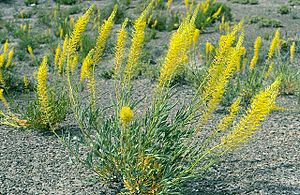Stanleya (plant) facts for kids
Quick facts for kids Stanleya |
|
|---|---|
 |
|
| Stanleya pinnata | |
| Scientific classification |
|
| Kingdom: | Plantae |
| Clade: | Tracheophytes |
| Clade: | Angiosperms |
| Clade: | Eudicots |
| Clade: | Rosids |
| Order: | Brassicales |
| Family: | Brassicaceae |
| Genus: | Stanleya Nutt. |
| Species | |
|
6 - See text |
|
Stanleya is a group of six types of plants. They are often called prince's plumes because their flowers grow in tall, feathery shapes. These plants are part of the Brassicaceae family, which also includes plants like cabbage and mustard.
Prince's plumes can be small plants or taller, upright shrubs. They have thick clusters of flowers that look like plumes or feathers. The flowers can be white or bright yellow. They also have long, thin parts called stamens.
You can find Stanleya plants growing naturally in the western parts of the United States. These plants are special because they can take in a substance called selenium from the soil. Because of this, prince's plumes can be harmful if eaten. It's important to know that these plants are not safe for people or animals to eat.
Contents
Types of Prince's Plumes
There are six different kinds of Stanleya plants. Each one has its own unique features. Here are the main types:
- Stanleya albescens - This one is known as the white prince's plume.
- Stanleya confertiflora - This type is called the Oregon prince's plume.
- Stanleya elata - You might know this as the Panamint prince's plume.
- Stanleya pinnata - This is the desert prince's plume, often found in dry areas.
- Stanleya tomentosa - This type is called the woolly prince's plume.
- Stanleya viridiflora - This one is known as the green prince's plume.
Where Prince's Plumes Grow
Prince's plumes are native to the western United States. They are well-suited to the environments found in these regions. These plants often grow in dry, open areas. They can be found in deserts, grasslands, and rocky slopes. Their ability to absorb selenium helps them survive in certain soil types.
Why Prince's Plumes are Special
These plants are interesting because of how they interact with the soil. They are known as "selenium accumulators." This means they can take in and store a lot of selenium from the ground. While this makes them toxic to eat, it also makes them important for scientists to study. Understanding how these plants handle selenium can help us learn more about plant growth and soil health.
See also
 In Spanish: Stanleya para niños
In Spanish: Stanleya para niños

